Introduction: Why Clown Makeup Captivates Everyone

Clown makeup has been entertaining people for centuries, blending humor, artistry, and performance. From circus clowns to modern festival trends, it’s an instantly recognizable look that sparks joy and curiosity. Whether for Halloween, kids’ parties, or creative photo shoots, learning clown makeup can be both fun and surprisingly easy.
What Is Clown Makeup? A Simple Explanation for Beginners

Clown makeup involves exaggerated facial designs—bright colors, bold patterns, and expressive features—that highlight a playful character. It uses traditional white bases, colorful shapes, and dramatic lines to create emotions that are visible even from a distance. For beginners, clown makeup can be a playful way to explore face painting and character creation.
The History of Clown Makeup: From Tradition to Modern Trends

Clown makeup has deep roots in theater and circus history. Early European clowns used minimal designs, while modern performers incorporate vibrant palettes and intricate details. Today, clown makeup appears in festivals, cosplay, and even high‑fashion editorials, showing its versatility beyond the big top.
Essential Tools Every Clown Makeup Artist Needs

To get started, you’ll need:
- A high‑quality white base face paint
- Bold, bright face paints (red, blue, yellow, etc.)
- Fine brushes and makeup sponges
- Long‑lasting setting powder
- Skin‑safe makeup removers
Having these basics ensures your clown makeup lasts, looks vibrant, and is safe for your skin.
Understanding Clown Makeup Types: Classic, Auguste, and Character Clowns

Different clown types use specific makeup styles:
- Whiteface Clowns: Full white base with sharp, bold details
- Auguste Clowns: Flesh‑toned base with colorful, exaggerated features
- Character Clowns: Makeup tailored to a specific personality or role
Knowing your clown type helps you choose colors and designs that match your character.
Beginner Techniques for Applying Clown Makeup

Start with a clean, moisturized face, then:
- Apply the white or flesh‑toned base evenly.
- Sketch your designs with a makeup pencil.
- Fill in with vibrant colors, using brushes for details.
- Set everything with translucent powder for long wear.
Practice blending and line work to create polished, professional‑looking designs.
Creating Iconic Clown Features: Smiles, Teardrops, and Big Eyes

Clown makeup exaggerates facial expressions to convey joy, sadness, or mischief.
- Smiles: Bold, overdrawn lips in red or black
- Teardrops: Simple but powerful for sad clown looks
- Big Eyes: White eyeliner below the eye to create an open, cartoon‑like effect
Experimenting with these elements helps define your clown character.
Color Theory in Clown Makeup: Choosing the Right Palette

Colors convey mood and personality. Bright reds and yellows evoke happiness, while blues and purples add a whimsical or mysterious feel. Using complementary colors makes your clown makeup pop, especially under stage lighting or for photos.
Clown Makeup for Kids: Fun and Safe Designs

Children’s clown makeup should be simple, colorful, and gentle on sensitive skin. Use hypoallergenic face paints, avoid heavy layers, and create playful designs like stars, hearts, or rainbows. Keep the process short and fun to make kids feel comfortable.
Modern Clown Makeup Trends: From Circus to Social Media

Social media has transformed clown makeup into an art form. Influencers experiment with neon colors, glitter, and even minimalist clown looks. Whether you prefer classic or trendy styles, the possibilities for creative expression are endless.
Troubleshooting Common Clown Makeup Problems

- Smudging: Use setting sprays and waterproof paints.
- Cracking: Keep layers thin and hydrate your skin.
- Difficulty Removing: Use oil‑based removers for a gentle clean.
Practicing these solutions ensures your clown makeup looks fresh and lasts longer.
Long-Lasting Clown Makeup: Tips for All-Day Wear

For performances or events, longevity is key.
- Prime your skin before applying makeup.
- Choose long‑wear face paints and adhesives.
- Reapply setting powder throughout the day.
Proper prep keeps your clown makeup vibrant from start to finish.
Clown Makeup for Cosplay and Halloween: Standing Out

Clown makeup adds a unique twist to cosplay and Halloween costumes. Whether aiming for a spooky “creepy clown” or a cheerful circus performer, carefully chosen colors and designs make your look unforgettable. Pairing makeup with props completes the transformation.
Learning Clown Makeup Online: Tutorials and Courses

Platforms like YouTube and Skillshare offer step‑by‑step clown makeup tutorials for all levels. Many artists share techniques for both traditional and modern styles, making it easy to learn from home. Investing time in online lessons can dramatically improve your skills.
Building a Career as a Clown Makeup Artist

Clown makeup can be a rewarding profession, with opportunities in entertainment, children’s events, and even film. Build a strong portfolio by practicing on friends or models, then share your work on social media to attract clients. Networking and consistency are key to growing your career.
Safety and Skin Care When Using Clown Makeup

Always patch-test new products to avoid allergies. Use gentle, non‑toxic paints and remove makeup thoroughly after each use. Moisturize regularly to keep your skin healthy and ready for your next colorful creation.
Inspiring Clown Makeup Artists to Follow Online

Follow creators who push the boundaries of clown makeup design. Instagram and Pinterest are full of artists who share tutorials, behind‑the‑scenes content, and creative inspiration. Engaging with their work can spark your own ideas.
Conclusion: Bring Joy and Creativity with Clown Makeup

Clown makeup is more than bright colors—it’s about storytelling and connecting with people. Whether you’re a beginner or aspiring professional, exploring clown makeup opens doors to endless creativity. Pick up your brushes, experiment, and start bringing smiles to faces today!

Alexander Smith is an accomplished blogger with years of experience in crafting engaging and insightful content. Known for his expertise and passion for storytelling, Alexander brings a unique perspective to Fascinate Names, captivating readers with his thoughtful analysis and fresh ideas. His extensive background in digital media and writing makes him a valuable voice in the blogging community.







